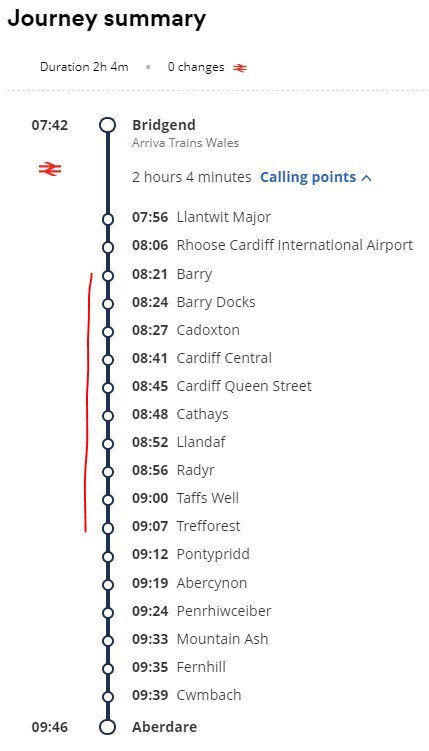Usefully daft: alphabetical public transport.
,
I wonder at what point in Michael Taylor's commute he realised that going from Ardwick to Ashburys to Fairfield to Guide Bridge to Hyde North was five stops in alphabetical order. But realise he did, and then even better, he asked if that was a record.
I can't resist such a challenge, especially not when I've been working on standards for Great Britain's public transport open data for the last few months. So I set about answering the question.
The longest chain of alphabetical stops.
Getting public transport timetables for Great Britain is pretty easy. Traveline collect, curate, and republish them for ferries, buses, coaches, trams, and metros in a complicated but consistent format called TransXChange. Some combination of The Association of Train Operating Companies and National Rail and The Rail Delivery Group publish their timetables via a body called RSP, which stands for Rail Settlement Plan, in a format called ATOC-cif, which is not really designed for humans to read, but makes sense after a few hours of staring at it.
If you spend a few days with all that data, and if you're pretty good at parsing XML and text, then you can end up with tools that find the longest chain of stops that are also in alphabetical order. So that's what I did.
- I've shared a GitHub repo for finding the longest chain of stops that are also in alphabetical order from TransXChange files.
- And I've shared GitHub repo for finding the longest chain of stops that are also in alphabetical order from TransXChange files.
Cardiff is the winner!
Those GitHub repos give lots more details, and full datasets for you to explore.
But most of you won't want to explore, you just want the results. So here they are.
The longest consecutive alphabetical rail journey in Great Britain is in South Wales, a 10 stop stretch from Barry to Trefforest, via Cardiff.
The longest consecutive alphabetical tram, metro, or light rail journey in Great Britain is in Manchester. The 6 stops West from Etihad Campus, to Holt Town, New Islington, Piccadilly, Piccadilly Gardens, and St Peter's Square.
The longest consecutive alphabetical bus journey is a tie between The Midlands and Yorkshire. Both have 11 consecutive alphabetical stops — the number 7 from Tamworth to Stonydelph (stops at Ealingham, Fossdale, Gayle, Grindsbook, Hawkside, Hebden, Lintly, Lowforce, Mellwaters, Mossdale, and Murton) and the number 205 from Dewsbury to Pudsey (stops at Commonside Black Labrador PH, Commonside Bromley Street, Commonside Wood Lane, High Street Commonside, High Street Highgate St, High Street Kirkgate, High Street Rathlin Rd, John Ormsby Way Leeds Rd, Owl Lane Dewsbury Rams Stadium, Windsor Rd Owl Lane, and Windsor Rd Windsor Close.

What's the point?
Although this isn't a very useful project, the fact that it is possible is hugely important to the UK.
Traveline are a small independent organisation who collect data from hundreds of public transport operators, local authorities, and passenger transport executives right across Great Britain. On a tight budget, with no national government funding, they organise, correct, and republish it in a single place, as open data, for anyone to use. They're proof, at a time when outsourcing has a bad name, that outsourcing can be extremely efficient.
It is the open data that they provide, provided for free and without restriction, that lets services like Google Maps and CityMapper give you public transport directions. It also allows useful analysis that helps plan public transport routes to ensure that people can get to jobs, services, and entertainment that improves their lives. When organisations like The Open Data Institute argue that Data is Infrastructure and when The National Infrastructure Commission agrees this is what they're talking about.
Knowing the longest chain of consecutive public transport stops that are also in alphabetically order is obviously not very important, but the fact that Great Britain's world-class data infrastructure makes it possible is.
